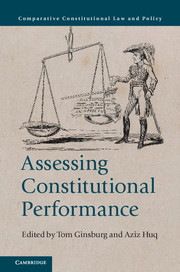Book contents
- Frontmatter
- Contents
- List of figures
- List of tables
- List of contributors
- Acknowledgments
- INTRODUCTION
- PART I DEFINING CONSTITUTIONAL PERFORMANCE
- PART II MANAGING SPECIFIC CONSTITUTIONAL CHALLENGES
- 6 Constitutional performance in transitions from military to civilian rule
- 7 Constitutional permissiveness, constitutional restrictiveness, and religious freedom
- 8 Performance of constitutions: Transitional provisions
- 9 Time and constitutional efficacy
- 10 Competitive democracy and the constitutional minimum core
- PART III CASE STUDIES
- Index
- References
10 - Competitive democracy and the constitutional minimum core
from PART II - MANAGING SPECIFIC CONSTITUTIONAL CHALLENGES
Published online by Cambridge University Press: 05 August 2016
- Frontmatter
- Contents
- List of figures
- List of tables
- List of contributors
- Acknowledgments
- INTRODUCTION
- PART I DEFINING CONSTITUTIONAL PERFORMANCE
- PART II MANAGING SPECIFIC CONSTITUTIONAL CHALLENGES
- 6 Constitutional performance in transitions from military to civilian rule
- 7 Constitutional permissiveness, constitutional restrictiveness, and religious freedom
- 8 Performance of constitutions: Transitional provisions
- 9 Time and constitutional efficacy
- 10 Competitive democracy and the constitutional minimum core
- PART III CASE STUDIES
- Index
- References
Summary
A central function of a written constitution is to enhance the stability of the political system that underpins it. Constitutions often do this by adopting formal norms of entrenchment, or imposing formal barriers to constitutional change that depend on more than mere legislative majority support. In some systems, political conventions and practices may serve the same function and create effective informal barriers to constitutional change. These formal and informal barriers to change help to protect institutions and values by entrenching them. Thus, recent literature has suggested that one key metric for the success of a constitutional order is its overall “endurance”, or capacity to withstand pressures for constitutional change (Elkins, Ginsburg, and Melton 2009).
We argue in this chapter that for those constitutions with a democratic starting point, one important criterion for constitutional success is the degree to which the constitution preserves a minimal or thin conception of competitive democracy. We do not argue that this is the sole criterion for success, but it does allow for relatively structured comparisons across countries and it would be difficult to argue that a constitution failing this criterion has been successful. Thus, constitutional designers and scholars working from a democratic starting point should be most concerned with the endurance of those parts of a democratic constitution protecting this thin version of democracy: what one might call the minimum core of a democratic constitution. The endurance of the minimum core is normatively important in determining constitutional success because the failure to protect the minimum core will lead to the erosion of democracy. However, the desirability of change to the rest of a democratic constitution is more ambiguous from a normative perspective; such change may be harmful, neutral, or even affirmatively beneficial from the standpoint of constitutional theory.
This point has consequences for both the conceptualization and measurement of constitutional change. From a conceptual perspective, it suggests that constitutions are heterogeneous documents with different kinds of levels of provisions, and changes at these different levels have different normative consequences. We distinguish at least two different levels at which constitutions operate: the minimum core and more ordinary law.
- Type
- Chapter
- Information
- Assessing Constitutional Performance , pp. 268 - 292Publisher: Cambridge University PressPrint publication year: 2016
References
- 10
- Cited by

